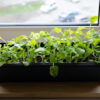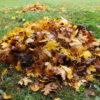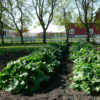Description
Vermont Cranberry Bush Bean
50 Seeds per pack
Days to Maturity: 60–75 days (fresh shell), 85–90 days (dry)
Sun Requirements: Full Sun
Botanical Name: Phaseolus vulgaris
A cherished New England heirloom dating back to the 1800s, the Vermont Cranberry Bean was once a staple food through the long winters of the Northeast. Bush-type plants stand upright and productive, bearing abundant 5–6″ pods that mature to a striking red-mottled pattern. Inside are 5–6 medium-sized, oval beans in a rich rosy-maroon hue streaked and speckled with darker burgundy, closely resembling their cranberry namesake.
Maturing in 60–75 days as a fresh shelly bean or 85–90 days as a dry bean, this hardy variety thrives in shorter-season, cool-climate regions. Prized for its sweet, full-bodied flavor, the Vermont Cranberry Bean excels both fresh and dried.
As a shelly bean, it offers tender, succulent texture; when dried, it cooks to a creamy consistency without losing its shape. Its versatility makes it a great addition to the kitchen, where it’s a tasty addition to hearty soups, stews, casseroles, and cold bean salads, or simply simmered with olive oil and garlic for a old fashioned, satisfying dish.
Reliable, high-yielding, and easy to grow, this classic bean remains a favorite for gardeners seeking beauty, flavor, and dependable harvests!
Planting Instructions for Vermont Cranberry Bean Seeds
When to Plant
Sow seeds outdoors once all danger of frost has passed and soil temperature reaches at least 60°F, ideally 70–80°F. This is usually 1–2 weeks after the average last frost date. Vermont Cranberry Beans are frost-sensitive and should not be planted in cold, wet soil.
Where to Plant
Choose a location with full sun and well-drained soil. Avoid low areas where water collects. A soil pH of 6.0–6.8 is best. Work compost into the soil before planting for improved fertility.
How to Plant
Do not soak seeds before planting. Sow directly outdoors 1″ deep, spacing seeds 2–4″ apart in rows 18–24″ apart. If starting indoors, plant 1–1.5″ deep and harden off before transplanting. Cover seeds lightly with soil.
Growing Notes
Bush-type plants stand upright and productive, bearing abundant 5–6″ pods that mature to a striking red-mottled pattern. Inside are 5–6 medium-sized, oval beans in a rich rosy-maroon hue streaked with darker burgundy. Vermont Cranberry Beans thrive in cooler, short-season climates, are high-yielding, and rarely require extra fertilizer. Keep soil evenly moist during flowering and pod fill. Apply mulch to retain moisture, reduce weeds, and prevent soil splash.
Succession Planting
Typically grown for dry or shelly beans, producing one main crop. Staggered planting is generally unnecessary unless an extended fresh shelly bean harvest is desired.
Pests and Problems
Watch for Mexican bean beetles, aphids, and fungal or bacterial diseases. Remove affected foliage and rotate crops every 3 years. Avoid handling plants when wet.
Harvesting
For shelly beans, harvest at 60–75 days when pods are fully colored and seeds are plump. For dry beans, harvest at 85–90 days when pods are brittle and beans rattle inside.
- Option 1: Pull whole plants and hang in a dry, ventilated space.
- Option 2: In humid areas, pick pods as they dry and finish drying indoors.
Shell by hand or by gently stomping pods in a sack. Winnow to remove chaff. Beans must be fully hard before storage.
Storage
Store dried Vermont Cranberry Beans in airtight containers in a cool, dark place. For long-term storage (5–10 years), use mylar bags or #10 cans with oxygen absorbers.
Cooking Tips
Excellent in hearty soups, stews, casseroles, and cold bean salads. Sweet, full-bodied flavor and creamy texture. Soak overnight, boil 10 minutes, then simmer until tender. Cooked beans freeze well in cooking liquid.
Seed Saving
Select mature, healthy pods for seed. Shell and dry thoroughly before storing in seed saving envelopes or airtight containers in a cool, dry, dark location. Seeds remain viable for 3–5 years.
FAQ:
What makes Vermont Cranberry Bush Beans special?
This heirloom dates back to the 1800s and was a staple food for New England families through long winters. The beans are beautiful—rosy-maroon with burgundy streaks—and have a sweet, rich flavor. They can be enjoyed fresh or dried, making them a versatile choice for the kitchen.
Do Vermont Cranberry Bush Beans need a trellis or support?
No. They are a true bush-type variety, so the plants grow upright and sturdy without a trellis. This makes them easy to grow in garden beds, raised beds, or even large containers.
How long does it take Vermont Cranberry Beans to grow?
You can harvest fresh shelly beans in about 60–75 days after planting, or let them fully mature for dry beans in 85–90 days. Both stages offer excellent eating quality.
What are shelly beans?
Shelly beans are beans picked when the pods are fully formed but before the beans have completely dried. At this stage, the beans are plump, tender, and flavorful—perfect for cooking fresh. Vermont Cranberry Beans make excellent shelly beans thanks to their rich, sweet taste and creamy texture.
How much do Vermont Cranberry Bush Beans produce?
They’re known for being reliable, high-yielding plants. Each bush produces multiple pods at once, with each 5–6″ pod holding 5–6 plump beans. A small planting can provide a generous harvest for fresh eating, drying, and storage.
What’s the best way to cook dried Vermont Cranberry Beans?
For dried beans, soak overnight, boil for 10 minutes, then simmer until tender. They’re perfect for hearty soups, stews, chili, cold salads, or simply cooked with olive oil and garlic for an old-fashioned side dish.
Will Vermont Cranberry Beans grow well in short-season gardens?
Yes. This variety is, while still frost sensitive, well-adapted to cooler climates and shorter growing seasons. Even in areas with more limited warm weather, it produces a dependable, abundant crop.
Can I save Vermont Cranberry Bean seeds for planting next year?
Absolutely. Choose healthy, mature pods, dry them fully, shell the beans, and store them in seed envelopes or airtight containers in a cool, dry, dark place. They stay viable for 3–5 years.
How long will dried Vermont Cranberry Beans store for food use?
If kept in an airtight container in a cool, dark location, they’ll stay good for years. For extra-long storage—up to 5–10 years—use mylar bags or #10 cans with oxygen absorbers.

















Reviews
There are no reviews yet